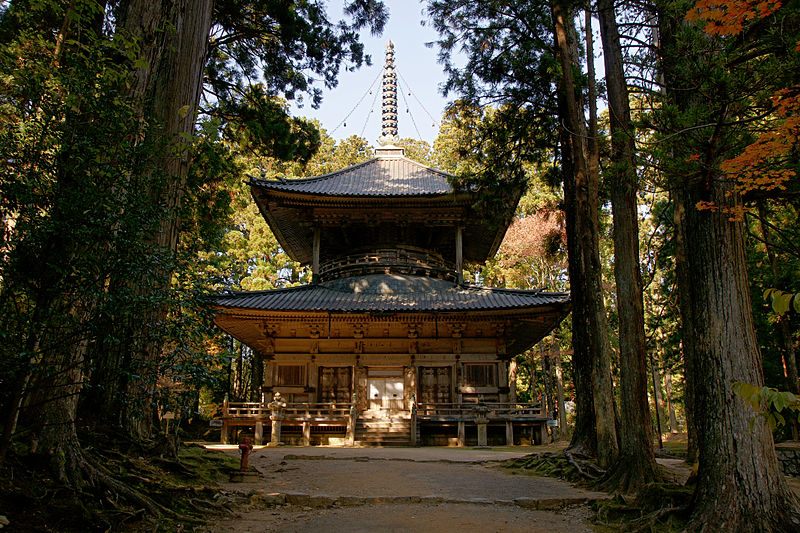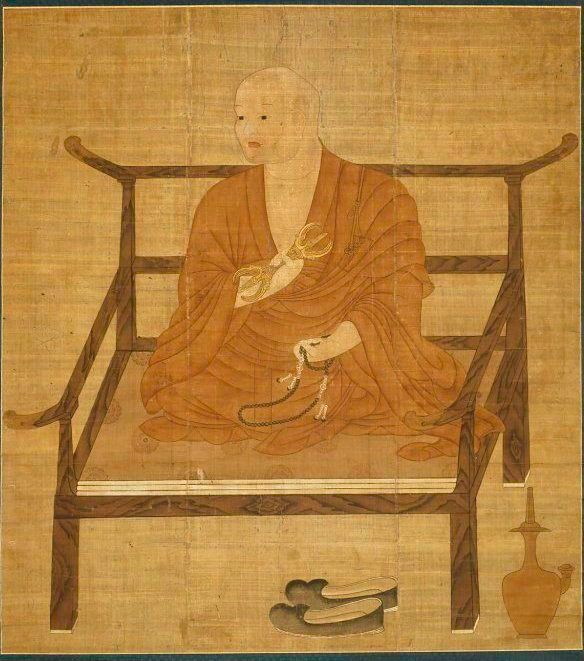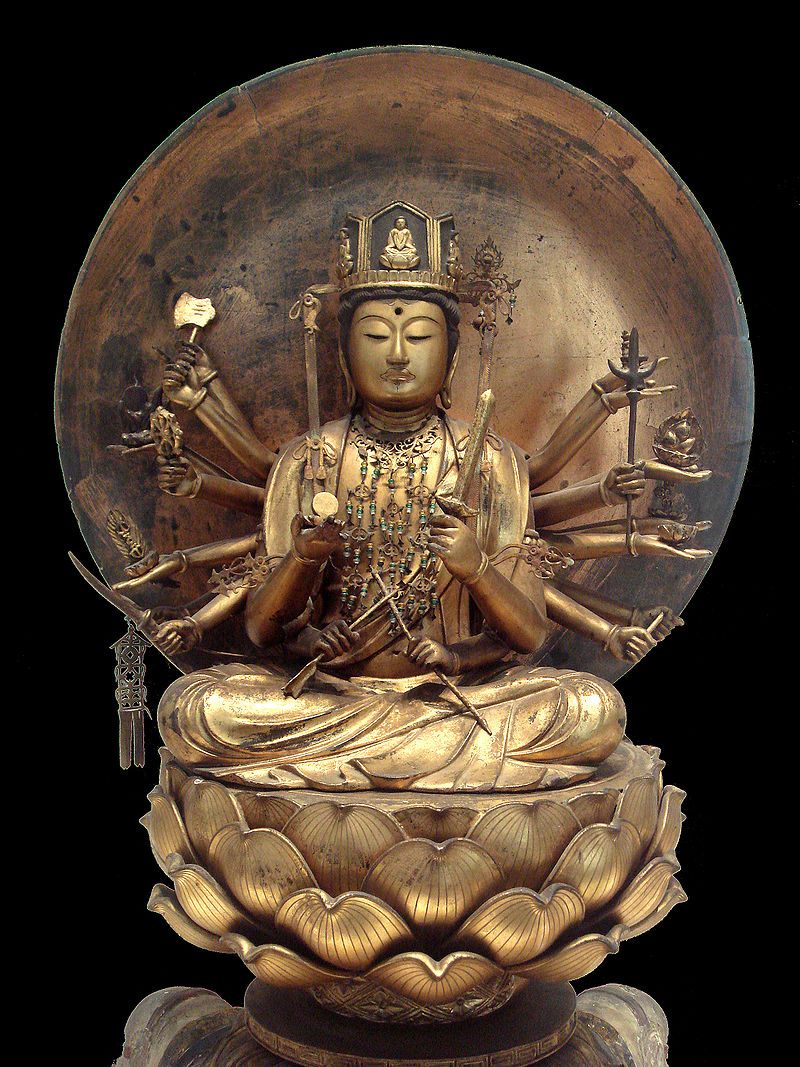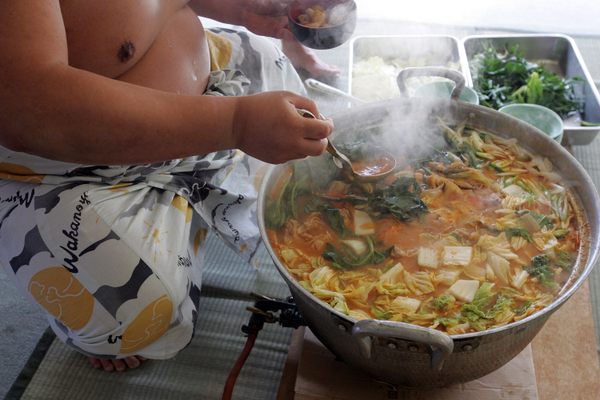The Monks Who Spent Years Turning Themselves into Mummies—While Alive
Japan’s self-sacrificing sokushinbutsu were a very determined lot.

Danjōgaran, a temple on Mount Kōya in Japan. (Photo: V663highland/CC BY-SA 3.0)

The Japanese climate is not exactly conducive to mummification. There are no peat bogs, no arid deserts, and no alpine peaks perennially encased in ice. The summers are hot and humid. Yet somehow a group of Buddhist monks from the Shingon sect discovered a way to mummify themselves through rigorous ascetic training in the shadow of a particularly sacred peak in the mountainous northern prefecture of Yamagata.
Between 1081 and 1903, at least 17 monks managed to mummify themselves. The number may well be higher, however, as it is likely some mummies were never recovered from the alpine tombs.
These monks undertook such a practice in emulation of a ninth-century monk named Kūkai, known posthumously as Kōbō Daishi, who founded the esoteric Shingon school of Buddhism in 806. In the 11th century a hagiography of Kūkai appeared claiming that, upon his death in 835, the monk did not die at all, but crawled into his tomb and entered nyūjō, a state of meditation so profound that it induces suspended animation. According to this hagiography, Kūkai plans to emerge in approximately 5.67 million years to usher a predetermined number of souls into nirvana.
The first recorded attempt at becoming a sokushinbutsu, or “a Buddha in this very body,” through the act of self-mummification took place in the late 11th century. In 1081, a man named Shōjin attempted to follow Kūkai into nyūjō by burying himself alive. He, too, was hoping to come back in a far distant future for the good of mankind, but when Shōjin’s disciples went to retrieve his body, rot had set in. It would take nearly two more centuries of trial and error before someone figured out how to mummify himself and, they believed, cheat death to enter a state of eternal meditation.

A portrait of Kōbō Daishi from the 14th century. (Photo: Art Institute of Chicago/Public Domain)
The process of self-mummification is long and arduous, taking at minimum three years of preparation before death. Central to this preparation is a diet called mokujikigyō, literally “tree-eating training.” This diet can be traced through Shugendō to the Taoist practice of abstention from cultivated grains.
For a thousand days, the mokujikigyō diet limits practitioners to only what can be foraged on the mountain, namely nuts, buds, and roots from trees. Some sources also report that berries may have entered the diet, as well as tree bark and pine needles. Time not spent foraging for food was passed in meditation on the mountain.
From a spiritual perspective, this regimen was intended to toughen the spirit and distance oneself from the common human world. From a biological point of view, the severe diet rid the body of fat, muscle, and moisture while also withholding nutrients from the body’s natural biosphere of bacteria and parasites. The cumulative effect was to arrest decomposition after death.
At the completion of a thousand-day cycle on this diet, practitioners were considered spiritually ready to enter nyūjō. However, most monks completed two or even three cycles to fully prepare themselves. After the final cycle, the devout would cut out all food, drink a limited amount of salinized water for a hundred days, and otherwise meditate upon the salvation of mankind while waiting to die.

A wooden statue of Kōbō Daishi. (Photo: PHGCOM/CC BY-SA 3.0)
Many believe that some adherents at this stage drank tea made from Toxicodendron verniculum tree bark. A kind of sumac, the Japanese lacquer tree is called such because it is used to make traditional Japanese lacquer, urushi. Its bark contains the same toxic compound that makes poison ivy so poisonous. If ingested by these monks, urushi tea would have both hastened death and made the body even less hospitable to the bacteria and parasites that aid in decomposition.
When the devout felt death approaching, his disciples would lower him into a pine box at the bottom of pit three meters deep in a predetermined spot. They would then pack charcoal around the box, insert a bamboo airway through the lid, and bury their master alive. Sitting in total darkness, the monk would meditate and regularly ring a bell to signal that he was still alive. When the ringing ceased, the disciples would open the tomb to confirm their master’s death, remove the bamboo airway, and seal the tomb.
A thousand days later, the monk would be disinterred and inspected for signs of decay. If any such signs were found, the body would be exorcised and reinterred with little fanfare. If not, the body was determined to be a true sokushinbutsu and enshrined.
The last person to become a sokushinbutsu did so illegally. A monk named Bukkai died in 1903, more than three decades after the ritual act was criminalized during the Meiji Restoration because the new government deemed it barbaric and backwards.
By then Japan had entered the modern age, and most people considered Bukkai more madman than sage. His remains were not disinterred until 1961 by a team of researchers from Tohoku University, who were amazed by Bukkai’s pristine condition. Though he entered nyūjō in Yamagata, his remains now rest in Kanzeonji in neighboring Niigata Prefecture. There are 16 extant sokushibutsu in Japan, 13 of which are preserved in the Tohoku region. Seven of the eight found in Yamagata remain in the vicinity of Mt. Yudono, making it the ideal place for a pilgrimage.

Kanzeonji, the location of Bukkai’s remains. (Photo: Jakub Hałun/CC BY-SA 4.0)
The oldest and best preserved of these mummified monks can be found at Dainichibō, mentioned above. His name is Shinnyokai, and he entered nyūjō in 1783 at the age of 96. Like all the others, he sits in the lotus position behind glass in a box on small shrine within the temple that looks after him. His skin is an ashen grey, pulled taught over the bones of his hands, wrists, and face. His mouth is stretched into an eternal jackal’s grin, his face turned towards his lap.
Shinnyokai’s elaborate robes are ritually changed every six years, twice as often as all the other sokushinbutsu. The old robes are cut into small squares and placed inside padded silk pouches that can be purchased for ¥1,000 as protective amulets. Testimonials sent in by people swearing by these talismans’ miraculous effects are plastered around the base of Shinnyokai’s shrine.
Another sokushinbutsu, Tetsumonkai, resides at nearby Churenji, also mentioned above. Tetsumonkai entered nyūjō in 1829 at the age of 71, and of all the sokushinbutsu, his life is perhaps the best documented. Tetsumonkai was a commoner who killed a samurai and ran away to join the priesthood, an act that allowed him full legal protection. Later, Tetsumonkai visited the capital city Edo, present-day Tokyo. There he heard about an ophthalmic disease afflicting the city and gouged out his own left eye as an act of merit that might counteract the malady. Incredibly, Tetsumonkai is one of several sokushinbutsu to auto-enucleate—remove one’s own eye—as a charitable act.

Samantabhadra, one of the 13 Buddhas of Shingon Buddhism. (Photo: PHGCOM/CC BY-SA 3.0)
Tetsumonkai once served as head priest at Honmyōji, a short drive from where his remains are now kept. Here he was charged with looking after another sokushinbutsu, Honmyōkai, the oldest self-mummified monk in Yamagata. The samurai-turned-priest Honmyōkai spent a mindboggling 20 years in ascetic training until May 8, 1681, when his disciples lowered him, delirious with hunger, into a pit behind the temple and buried him alive. A massive, moss-covered stone epitaph marks the site where Honmyōkai entered nyūjō amid a grove of pine trees only a few dozen meters beyond the hall where his remains are now displayed.
These three sokushinbutsu are by far the closest to Mt. Yudono and the sites of their respective training. Dainichibō and Churenji are accustomed to tourists, and on weekends visitors are likely to encounter gaggles of retirees being ushered on and off the air-conditioned coaches that stop by these temples on their way to or from Mt. Yudono. The ¥500 admission Dainichibō and Churenji each charge, along with sales from protective amulets and other trinkets, keep the temple doors open and their history alive. Honmyōji charges no admission and receives fewer guests, but they’re still happy to show off their wish-granting mummy. The temples are happy with the attention and even went so far as to issue a sokushinbutsu stamp card in 2015, along with Nangakuji in the nearby city of Tsuruoka, to encourage visitors to stop by all four temples.
Nangakuji houses Tetsuryūkai, who was mummified in 1878, a decade after the practice was made illegal. Tetsuryūkai died of illness before he could complete his training and so is not technically a sokushinbutsu. His body is artificially treated in order to better preserve it, and the relatively simple shrine surrounding his remains offer the closest look one can get of a mummified monk in Yamagata. Tetsuryūkai’s failure to properly enter nyūjō is written all over his face, the skin of which is peeling away from his nasal cavity.
Kaikōji houses two sokushinbutsu. Chūkai, who died in 1755, and his former disciple, Enmyōkai, who died in 1822, now sit side by side in eternal meditation. Despite their difference in age you’d think they were brothers. They have the same taut, glossy and blackened skin, as well as the same bony hands, sunken eyes, and gaping toothy mouths.








Follow us on Twitter to get the latest on the world's hidden wonders.
Like us on Facebook to get the latest on the world's hidden wonders.
Follow us on Twitter Like us on Facebook